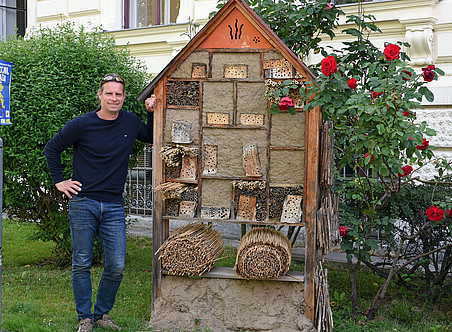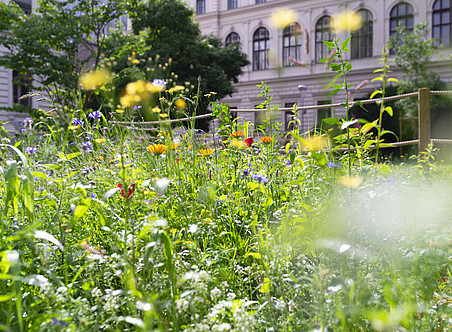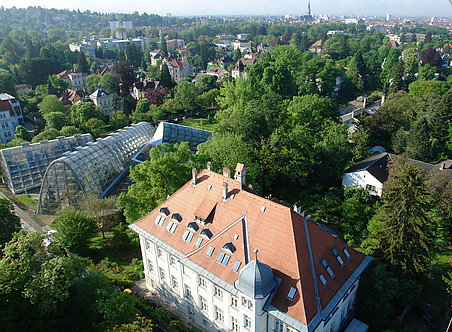The pretty sand lizard – during the mating season the males impress in green – was once widespread in Graz. Today, there are only a few isolated populations left in the city, the largest of which is in the Botanical Garden and the surrounding area.
Wilderness corridor in the city
With a total of around 600 trees, plus hedges, shrubs and perennials, lawns and flowering areas as well as gardens, the University of Graz campus offers valuable habitats for flora and fauna. In addition to Universitätsplatz, the area includes several locations - from the Training and Diagnostics Centre at Rosenhain to the Wall building in Merangasse.
"As one of the largest green spaces in Graz, the campus is an important biotope and forms a corridor for the spread of species as a bridge between the Stadtpark and Hilmteich," explains Christian Sturmbauer from the Institute of Biology at the University of Graz. "The Botanical Garden in particular, with its old trees, is an important stepping stone towards Leechwald", says the biodiversity expert.
For more biodiversity
In recent decades, biodiversity has declined massively in many places. However, it is crucial for functioning ecosystems and thus for the preservation of our livelihoods. The University of Graz has therefore set itself the goal of promoting biodiversity with various measures. The first steps have already been taken. In 2023, the campus received a total of 50 new trees and a flowering strip on the north meadow on Universitätsplatz as a source of food for bees and other insects. More shrubs and perennials have also been planted. Experts from the Botanical Garden contributed their knowledge. Among other things, they made sure that climate-resistant, primarily native plants that are attractive to insects and birds, such as rowanberry and elderberry, were selected.
In front of the Universitätsplatz 2 building, the trunk of a felled plane tree has been providing a deadwood habitat for a community of fungi, insects, woodlice and other organisms for several months. Right next to it, a "4-star" insect hotel beckons. Biologist Gernot Kunz has researched which structures in nesting aids are particularly valuable for species relevant to nature conservation and has built them in. "Our insect hotel was used by the red mason bee, the European orchard bee, the giant resin bee, the blue cuckoo wasp and a species of digger wasp, among others," reports Kunz. "However, accompanying investigations have shown that the nesting aid is too shallow. We will therefore be replacing the frame to give the nest more depth," explains the insect expert. "Luxury" hotels optimised in this way will soon be erected at other locations.
The University of Graz received support from the Bundesimmobiliengesellschaft to promote bird biodiversity. It sponsored 20 nesting boxes, which were attached to trees on campus.
"HeinrichBiCool" is the name of the recently launched project to green the University Centre for Theology at Heinrichstraße 80, which aims to cool the building and create a new biodiverse habitat at the same time. There will also be plenty of greenery around the Graz Centre of Physics, which is currently under construction, with rows of trees providing shade and a park-like city terrace.
ÖKOTEAM Graz has just analysed the possibilities for promoting biodiversity across the entire campus. Together with experts from the Department of Biology, further measures are now to be planned and implemented.




